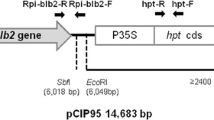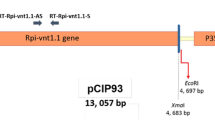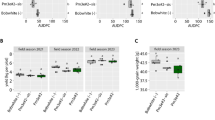Abstract
During evaluation of potato clones and cultivars from the Cornell seed production program to confirm their resistance toGlobodera rostochiensis (Wollenweber) Behrens (golden nematode) pathotype Ro1, several cysts developed on the transgenic cultivar Atlantic NewLeaf. This transformed cultivar resulted from the insertion of aBt endotoxin gene into the golden-nematode-resistant cultivar Atlantic. In subsequent bioassay tests, golden nematode cysts developed freely on the transgenic cultivar that originated from Atlantic NewLeaf clone 6, but not on Atlantic NewLeaf clones 31 and 36. Clones 31 and 36 were from differentBt transformation events of the cultivar Atlantic that were never commercialized. RFLP analysis of Atlantic used in the transformations and the Atlantic NewLeaf clones 6, 31, and 36 showed that they possessed the marker for theH 1 gene that confers resistance to golden nematode pathotype Rol. These data indicate that theBt transformation process adversely affected the expression of theH 1 gene in the transgenic cultivar Atlantic NewLeaf. This finding highlights the importance of pre-release evaluation of transgenic plants for any previously known major traits such as pest and disease resistance before they are commercialized.
Resumen
Durante la evaluación de clones y cultivares de papa realizados en el programa de producción de semilla de Cornell, para confirmar su resistencia aGlobodera rostochiensis (Wollenweber) Behrens (nematodo dorado) patotipo Ro1, desarrollaron varios quistes en plantas del cultivar transgénico Atlantic New Leaf. Este cultivar transformado es el resultado de la inserción de un gen de endotoxinaBt al cultivar resistente Atlantic. En bioensayos subsiguientes, los quistes del nematodo dorado desarrollaron libremente en el cultivar que se originó del clon 6 de Atlantic New Leaf, pero no en los clones 31 y 36 de este mismo cultivar. Los clones 31 y 36 provienen de diferentes eventos de transformaciónBt del cultivar Atlantic que nunca fueron comercializados. Los análisis de RFLP de Atlantic utilizado en las transformaciones y los clones 6, 31 y 36 de Atlantic New Leaf demostraron poseer el marcador para el genH 1 que confiere resistencia al patotipo Rol del nematodo dorado. Estos datos indican que el proceso de transformaciónBt afecta adversamente la expresión del genH 1 en el cultivar transgénico Atlantic New Leaf. Este hallazgo destaca la importancia que tiene la evaluación de plantas transgénicas antes de su liberación, con el objeto de determinar cualquier característica importante previamente conocida como es el caso de la resistencia a plagas y enfermedades, antes de que sean comercializadas.
Similar content being viewed by others

Literature Cited
Bergelson, J, CB Purrington, and G Wickmann. 1998. Promiscuity in transgenic plants. Nature 395:25.
Brodie, BB. 1998. Potato. In KR Barker, GA Pederson, and GL Windham (eds), Plant and Nematode Interactions. Agron Monograph No. 36.
Brodie, BB. 1999. Classical and molecular approaches for managing nematodes affecting potato. Can J Plant Path 21:222–230.
Choi, KH, JJ Heung, KH Soon, JJ Hee, and J Hyouk. 1999. Stability of transgenic potato plants and their progenies expressing herbicide resistant gene. J Korean Soc Hort Sci 40:31–34.
Conner, AJ, MK Williams, DJ Abernethy, PJ Fletcher, and RA Gent. 1994. Field performance of transgenic potatoes. NZ J Crop Hort Sci 22:361–371.
Fenwick, DW. 1940. Methods for the recovery and counting of cysts ofHeterodera schachtii from soil. J Helminth 18:155–172.
Giovanni, GD, LS Watued, RJ Seidler, and F Widmer. 1999. Comparison of parental and transgenic alfalfa rhizosphere bacterial communities using biolog GN metabolic fingerprinting and Enterobacterial Repetitive Concensus Sequence-PRC (ERIC-PCR). Microbiol Ecol 37:129–139.
Hoy, CM. 1999. Colorado potato beetle resistance management strategies for transgenic potatoes. Am J Potato Res 76:215–219.
Kumpatia, SP, MB Chandrasekharan, LM Iyer, G Li, and TC Hall. 1998. Genome intruder scanning and modulation systems and transgenic silencing. Trends Plant Sci 3:97–104.
Mai, WE 1977. Worldwide distribution of potato-cyst nematodes and their importance in crop production. J Nematol 9:30–34.
Pineda, O, MW Bonierbale, RL Plaisted, BB Brodie, and SD Tanksley. 1993. Identification of RFLP markers linked to theH 1 gene conferring resistance to the potato cyst nematodeGlobodera rostochiensis. Genome 36:152–156.
Twomey, U, T Raftery, K Devine, and PW Jones. 1995. An improved procedure for assaying hatching activity towardsGlobodera rostochiensis. Nematologica 41:258–268.
Author information
Authors and Affiliations
Corresponding author
Rights and permissions
About this article
Cite this article
Brodie, B.B. The loss of expression of theH 1 gene inBt transgenic potatoes. Am. J. Pot Res 80, 135–139 (2003). https://doi.org/10.1007/BF02870212
Accepted:
Issue Date:
DOI: https://doi.org/10.1007/BF02870212



